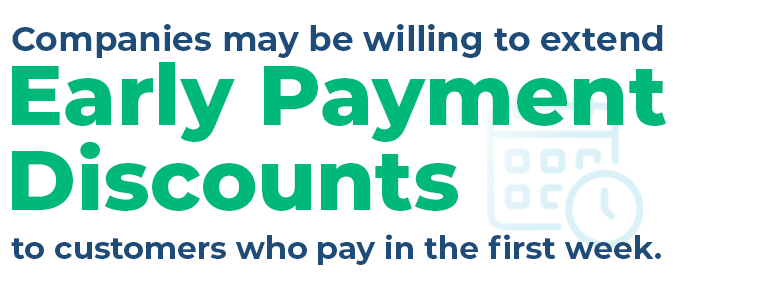
Net 30 payment terms are among the most common invoice payment terms, but whether they’re ideal for you depends on your business, goals, and other factors. On this page, you’ll learn what net 30 terms are, get an overview of similar terms, and explore alternatives.

Step 1.
Agree on Payment Terms
Setting clear expectations upfront helps prevent misunderstandings and disputes later on.

Step 2.
Create Invoice & Submit it
It ensures that the client has all the necessary information to process the payment quickly.

Step 3.
Payment Tracking & Collection
If the client pays by the due date, ensure that the payment is correctly recorded in your accounting system.

Step 4.
Follow-Up on Late Payments
Addressing late payments is crucial for cash flow, reducing bad debt risk, and showing clients you enforce your payment terms.
How Do Net 30 Payment Terms Work?
If you operate a B2B company in virtually any industry in the business world, you’ll be responsible for determining your payment terms. Some companies require payment in advance, while others expect payment at the time of service or sale. A final option is to allow the customer to pay at a later date. This technically means giving them short-term financing or offering them one of the most popular forms of trade credit, usually without charging interest, but most small businesses simply see it as invoicing.
What Does Net 30 Mean on an Invoice?
Net 30 is a term used to define when a customer must remit payment. In most cases, it means payment is due 30 days from the date listed on the invoice. Put simply, the customer has 30 calendar days to pay their bill in full. These net payment terms are considered a standard payment arrangement in many industries.
You may also come across variations such as net 10, net 15, or net 60, depending on how long you’re willing to wait for payment. In the U.K., a term like “net 30, end of month” means the invoice is due at the end of the following month. For example, if the invoice is dated December, payment is due by the end of January.
Offering net terms can support customer retention, but it’s important to know how managing net terms affects your cash flow. While providing net terms may attract more clients, they can also delay revenue. If you decide to extend net 30, consider sending payment reminders as the deadline for payment approaches or offering discounts to encourage early payment.
Whether net 30 payment terms are right for your business depends on your industry, client behavior, and cash flow needs. By understanding the advantages and disadvantages of net terms, you can decide whether to offer flexibility or require faster payments.
Net 15 vs Net 30: The Differences in Payment Term
When it comes to payment terms, understanding the differences between net 15 and net 30 can be crucial for managing your cash flow efficiently. Net 30 means that the customer has 30 days to pay the invoice, while net 15 gives the customer a shorter timeframe of only 15 days
Customers who use net 30 payment terms may appreciate the longer payment terms, as it allows them more time to settle their account. However, as a business owner, you may want to consider offering net 30 payment terms to your customers to attract more sales.
When deciding if net 30 terms are right for your business, it’s important to weigh the pros and cons. While net 30 can be seen as generous payment terms that may attract more customers, it can also lead to longer payment cycles and potential cash flow issues. Alternatively, you may want to explore net 10 or net 15 terms for quicker payments. To learn more about net 30 and how it can impact your business, it’s essential to educate yourself on the terms and how to manage them effectively
Early Payment Discounts May Also Be Denoted with Net 30 Terms

Sometimes, companies want to give their customers the convenience of flexible invoice payment terms, but would also like to encourage prompt payment. To do this, they give the customer 30 calendar days to pay, while offering incentives if they clear their dues within a specific number of days after the invoice is issued. If they pay after their discount term, they’re responsible for the net amount. For example, a company may be willing to wait 30 days for payment, but will provide an incentive for paying sooner by giving an early payment discount to customers who pay in the first week. The invoice or contract would then say “5/7 net 30.”
How Do 1/10 Net 30 Payment Terms Work?
An invoice may indicate that a buyer will provide a net 30 payment period to the customer, but in order to encourage even quicker payment, they will offer a discount of 1% off the total cost if the customer pays within 10 days. This would be written as ‘1/10 net 30’. ‘Net 30’ signifies the overall payment deadline, the first number signifies the percentage discount, and the second number signifies the time period for payment when the discount is available.
If you’d like to negotiate a 2/10 net 30 discount with your vendors or sellers, this is how it works.
2/10 Net 30 Calculations
Suppose you purchased $1,000 worth of merchandise on the 13th. You may be eligible for a 2% discount if you pay the vendor’s invoice amount between the day it was sent, for example, on the 5th and on or before the 15th (which marks the 10-day time frame for receiving the discount).
You will be liable for the entire invoice without any discounts if you fail to meet the payment terms of 2/10 net 30 (Paying the discounted amount within the 10 days).
You can create your own terms in the same manner. Simply write them as (percentage discount)/(number of days in the discount period) net (number of days to make the full payment):
Discount (2%) x The Full Amount ($1,000) = Discounted Amount ($980)
When exactly does net 30 start?
Most of the time, net 30 means the customer must pay within 30 calendar days of the invoice date. However, it can also mean 30 days after purchases are made, goods are delivered, work is complete, and so forth. Shorter terms might also mean days after receipt of the invoice. Your contract and all invoices sent should be specified.
What are the benefits of using Net 30?
Offering net 30 payment terms can be helpful for a variety of reasons.
Winning Bids/ Securing New Clients: Companies will often choose to work with a vendor based on their payment terms. Offering net 30 can help ensure they choose you over another provider.
Working with Large Companies: Many large companies have a lengthy payment process, and invoices can require multiple signatures before they’re paid. Others only send out payments once per week, biweekly, or even monthly. If you want to work with a large company, chances are you’ll have to relax your terms or lose out on the contract.
Customer Service: Offering your customers credit is helpful when building relationships and improving customer loyalty.
What Are the Disadvantages of Net 30?
Even though many small business owners don’t realize it, accepting payment at any point after a service is performed or goods are delivered is extending credit. So, it comes with all the drawbacks of giving a business loan.
Affordability: Startups and small businesses often simply can’t afford to extend any kind of credit.
Slower Cash Flow: Extending credit can create cash flow problems. Smaller businesses typically require faster payment in order to continue operations.
Potential for Late Payments: Even if you’re offering discounts for early payment and charging late fees, your customers may still pay after the payment due date.
Potential for Non-Payment: Unfortunately, sometimes businesses don’t pay at all. If you’ve extended them credit, your only recourse may be to take them to court, which isn’t always a viable option, depending on the amount owed.
Opportunity Cost: When your cash is tied up in the credit you’ve extended, you may not be able to purchase supplies or other goods and services your business needs to grow or accept more work. As a buyer, you might also miss out on discounts from your own suppliers.
How Do You Decide if Net 30 Terms Are Right For Your Business?
You’ll have to weigh the pros and cons of any business credit term you might offer. If you can afford to do it, and doing so will help your business operate or grow, net 30 can be beneficial.
The Importance of Timely Payments Under Net 30 Terms
Timely payments are crucial for businesses to maintain cash flow and meet financial obligations. If payments are not made on time, it can affect a company’s ability to pay its bills, employees, and suppliers. Paying within 30 days is a standard practice in many industries. It helps establish a positive relationship between the buyer and seller and allows suppliers to plan their cash flow and operations effectively.
Late payments can also strain business relationships, leading to disputes and even legal action. By paying on time, businesses demonstrate their reliability and integrity, which can result in better terms and conditions in future transactions. Overall, timely payments are essential for maintaining strong business relationships, ensuring financial stability, and promoting trust and credibility in the marketplace.
Factoring May Be Your Ideal Alternative to Net 30 Terms
Many small businesses like the idea of offering net 30 terms, but get caught up in the drawbacks, or simply can’t afford to wait 30 days for an invoice to be paid. If you fall into this bracket, invoice factoring may be your ideal solution. With factoring, you can offer your customers virtually any net terms you wish and then sell your unpaid invoices to a factoring company at a discount. The factoring company provides you with instant payment and then waits for the customer to pay them. To understand this process better, it’s helpful to know how invoice factoring works and how it can benefit your business.
Negotiating Favorable Payment Terms with Vendors: Strategies and Best Practices
1. Build a good relationship with your vendors by communicating regularly and being transparent about your needs and limitations.
2. Understand your own financial situation and be prepared to share this information with your vendors. If you are struggling to make payments on time, let them know and work together to find a solution.
3. Offer something in return for more favorable payment terms, such as a larger order or longer contract.
4. Negotiate for discounts or rebates in exchange for early payment or committing to a higher volume of purchases.
5. Consider requesting extended payment terms, such as net-60 or net-90, to give yourself more time to pay invoices.
6. Be willing to compromise and find a solution for both parties. Remember that maintaining a good relationship with your vendors is key to long-term success.
Connect with Viva Capital to See if You Qualify
Most businesses qualify for invoice factoring. If you’d like to find out if you’re a candidate, apply to factor with Viva Capital.
Frequently Asked Questions (FAQ)
What are the alternatives to net 30 terms?
There are several alternatives to net 30 terms, including shorter payment terms like net 15 and longer ones like net 60 or net 90. Some businesses also offer terms where full payment is due immediately, such as payment on delivery or payment in advance. Choosing the right term depends on your cash flow needs and customer payment history.
How can I decide if net 30 terms are right for my business?
When considering net 30 terms, evaluate your cash flow, customer relationships, and the impact on your business’s financial stability. It’s important to weigh the benefits and risks before deciding to use net 30 terms.
What are the pros and cons of net 30 terms?
The advantage of net 30 is that it can help build stronger client relationships by giving them more time to pay the invoice in full, potentially increasing sales. However, the downside is that waiting 30 days after the invoice date can impact cash flow, creating delays in receiving payment and increasing the risk of late payments. It’s essential to weigh these pros and cons based on your business’s financial needs.
How can I offer net 30 terms on an invoice?
To offer net 30 on an invoice, state that full payment is due within 30 days of the invoice date. It’s also helpful to include a clear description of any late payment fees that will apply if the invoice is not paid within the net 30 period. Consistently applying and communicating your payment terms can help customers understand and respect them.
Are there alternatives to Net 30 that I can consider?
Yes, businesses can explore various alternatives to net 30 terms, such as early payment discounts, cash on delivery, or electronic funds transfer. It’s important to choose payment terms that align with your business’s needs.
What does a 30-day payment term signify?
A 30-day payment term means that the invoice must be paid within a period of 30 days from the invoice date. This term is commonly used in business transactions to specify the payment due date.
Can I offer early payment discounts with net 30 terms?
Yes, you can incentivize quicker payments by offering early payment discounts with net 30 terms. For instance, you could offer a 2% discount if the customer pays the invoice within 10 days, which would be noted as “2/10 net 30.” This can encourage faster payments and improve cash flow, even when 30 days after the sale is the standard term.
How do I decide if a shorter payment term, like net 15, would work better?
Using a shorter payment term, such as net 15 or even net 20, may be suitable if you need a quicker cash flow turnaround. Shorter terms may also help reduce the risk of late or unpaid invoices. Ultimately, whether to offer net 30 or another term depends on your business’s operational needs and the payment reliability of your customers.
- 6 Proven Customer Retention Tips to Drive Long-Term Loyalty - June 4, 2025
- 5 Key Traits of a Top Factoring Company (And How Viva Stacks Up) - May 22, 2025
- The Impact of Late Payments: How Factoring Protects SMEs - April 11, 2025



